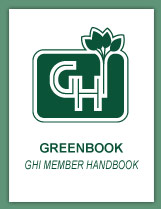VII. Fences
- STANDARDS FOR ALL FENCES
- Written permission in the form of a permit is required from GHI for all types of fences, either new or replacement. Replacement of existing fences, where more than twenty-five (25) percent is being replaced, must follow these rules. Fences shall be placed on designated perimeter yard lines with the following exceptions:
- Fence placement shall be setback twelve (12) inches from paved walkways or sidewalks, except where GHI staff determines a need for more room, and the setback shall be twenty-four (24) inches from parking areas or driveways.
- Fence placement shall be uniform bounding street rights-of-way and shall not create a visibility hazard for traffic or pedestrians.
- Fences are allowed to enclose the gardenside yard, or the side yard, or the combined gardenside and side yards, as defined in Yard Line Descriptions VI.B.3. No interior fences shall be permitted.
- GHI staff may authorize minor alterations to the overall perimeter placement rules (i.e. relative to yard lines) with
- individual offsets to avoid tangible obstacles (e.g. trees, hedges, downspouts, access obstructions, sidewalks),
- a uniform offset to avoid multiple interferences, or
- offsets (individual or uniform) to utilize locations of existing fence posts or request interpretation of the Board of Directors via the process described in Exceptions to Regulations, XX.
- Installation of adjacent man-made fences (e.g. chainlink, wood, vinyl, etc.) on a shared yard line is not allowed.
- THE FINISHED SIDE OF THE FENCE MUST ALWAYS FACE THE NEIGHBOR OR COMMON AREA.
- The maximum fence height shall be forty two (42) inches. Maximum post height shall not exceed forty eight (48) inches. The height and location of a protective barrier fence for a pool, pond, hot tub, or spa shall be as approved by the Board of Directors (see XIII.).
- All posts shall be set perfectly upright, in twelve (12) inches of concrete, in an eighteen (18) inch deep hole. Concrete may be omitted if the post is set in a hole 24 inches deep to prevent the fence from sagging.
- Posts made from trees or tree branches are not acceptable.
- Each fenced area of a gardenside or service-side yard shall be accessible from the adjoining common area or walkway by at least one (1) non-locking, thirty-six (36) inch wide gate opening; an end home with fence bordering both gardenside and service-side common area or access walk shall have two (2) gates. A gate shall be self-supporting, unobstructed, and shall be of similar material and design as the fencing. Common sidewalks established by GHI and access paths shall not be blocked by fences or additions. The location of the gate shall be approved by the Technical Services Department. Please bear in mind that in order for garbage collection to be made, the City of Greenbelt requires sufficient passageway to each unit so that trash collectors will have free access with their carts.
- Fence company name signs are considered undesirable and shall not be installed or hung on any new fence.
- Written permission in the form of a permit is required from GHI for all types of fences, either new or replacement. Replacement of existing fences, where more than twenty-five (25) percent is being replaced, must follow these rules. Fences shall be placed on designated perimeter yard lines with the following exceptions:
- CHAIN LINK: WIRE FENCES
- Existing chain link fencing is approved and shall remain in place, providing the material is sound and in good order, and that a top rail exists. The fences shall be maintained to keep the fencing and posts taut and in repair and free of all rust. All posts shall be capped. Repainting of chain link fencing with reflective (metallic) or bright colors is prohibited. Repainting shall be black, green or brown and shall match GHI approved vinyl coated fence wire colors. Paint must be exterior metal rated. Primer is recommended. Samples of GHI approved wire materials and paint colors are on file in the Management office.
- Painting and Color:
- For new installations, entire fence color to be black, brown or forest green.
- Repainting of chain link fencing with reflective (metallic) or bright colors is prohibited.
- Chain link fencing shall be maintained and be free of paint chips, scratches and rust. Any fence painted with a prior approved GHI fence paint color (black, brown, or forest green) may touch up imperfections (scratches, chips and rust) if less than 25% of the surface area needs touched up.
- Chain link fences needing repairs exceeding 25% shall be painted or coated in black, brown,or forest green only. Paint must be exterior metal rated. The use of primer is recommended.
- The screening of chain link fence with plants is highly recommended. Plant screening and trees shall not be permitted to grow in a manner that will adversely affect the fence. Wire fencing thinner than 16 gauge (.063”) is not allowed.
Definition of chain-link fence: a fence with continuous top rail, of galvanized steel or vinyl-clad metal wire (minimum 9 gauge thick), woven to form a diamond-shaped mesh.
- WOOD FENCES
- MATERIAL -Two types of wood materials are approved as follows: woodtreated to CCA retention of forty (40) pounds for both posts and fence material.
- CCA 40 pounds retention for the posts, untreated white wood for the fence material. (spruce, hem-fir, etc.)
- Pressure treated or rot resistant posts and fence material.
- INSTALLATION
- Posts shall be set three (3) inches off the yard line if no fence exists, in order to avoid problems in the future.
- On frame buildings the centerline of the first post shall be set six (6) inches from the face of the building. Fences shall not be attached to the building.
- Fence construction shall be accomplished in a neat, workmanlike manner.
- Hot dipped Galvanized or other approved fasteners for exterior application shall be used.
- Diagonal bracing is recommended at corners.
- FINISHING
- Pressure treated material shall be stained or painted.
- White wood shall be treated with a wood preservative before being stained or painted. Use of a preservative treated stain shall satisfy the requirement.
- Redwood shall be sealed with a clear finish. Finishes may be gloss or semi-gloss.
- No creosote shall be used.
- The finished fence must present a neat appearance on all sides.
- First coating of each board or post prior to construction will assure no exposed ends or bare spots between boards.
- UPKEEP AND SPECIAL CONDITIONS
- Wood fencing material must be free of such irregularities as loose or open knots, bark on edges, splinters, splits, etc.
- Wood picket fences are approved with the provision that the picket tops be rounded or flat.
- All work must be done in a neat workmanlike manner and in accordance with the specific fence design.
- Fences for the larger townhouses are to follow these regulations except that fences shall be allowed only on the non-street side of the home.
- MATERIAL -Two types of wood materials are approved as follows: woodtreated to CCA retention of forty (40) pounds for both posts and fence material.
- VINYL FENCES
- UPKEEP
- Vinyl fences should be free from moss, mold and mildew build up. Regular power or hand washing MUST be done regularly.
- All work must be done in a neat workmanlike manner and in accordance with the specific fence design.
- Fences for the larger townhouses are to follow these regulations except that fences shall be allowed only on the non-street side of the home.
Vinyl fences that conform to the styles approved (see VII section F Approved Styles) and to all other applicable requirements are allowed. All vinyl fences must be installed according to manufacturer's instructions.
- UPKEEP
- METAL FENCES
- UPKEEP
- Metal fences should be free from rust and mold build up. Regular power or hand washing should be done regularly. Steel/Iron rod fencing should be painted as needed. Bent, damage or rusted sections shall be repaired or replaced.
- All work must be done in a neat workmanlike manner and in accord with the specific fence design.
- Fences for the larger townhouses are to follow these regulations except that fences shall be allowed only on the non-street side of the home.
Metal fences that conform to the approved styles (see VII section F Approved Styles) and to all other applicable requirements are allowed. All metal fences must be installed according to manufacturer’s instructions and Prince George County regulations. Chain link fences may be black, brown or green; custom metal fences shall be black only.
- UPKEEP
- APPROVED STYLES
- Wood and Vinyl Approved Styles
- There are a number of styles of fences on the market today, both pre-built or built on the job site. A few of these are shown below.

Board and Post Estate2, 3, or 4 Board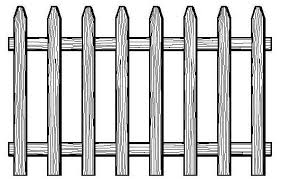
Picket Fence (Standard Arrow, Dog Ear, or Box Cut)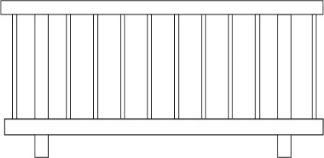
Wood Box Rail - Metal Approved Styles (Aluminum or Steel).
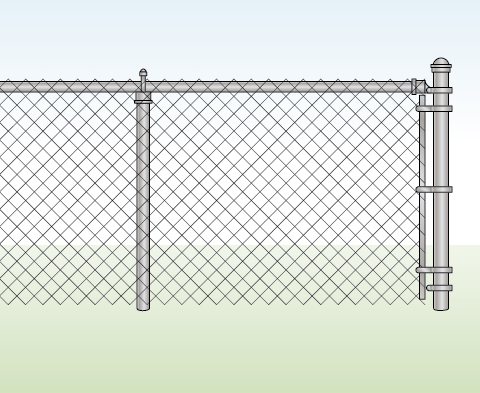
Chain Link
3-rail Box Top
2-rail Box Top - Mixed Material Fencing (custom builds)
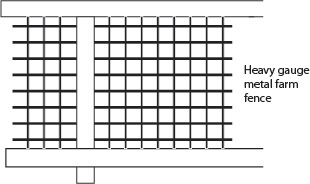
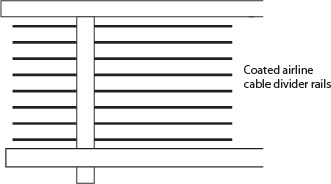
- There are a number of styles of fences on the market today, both pre-built or built on the job site. A few of these are shown below.
- Wood and Vinyl Approved Styles
- GUIDELINES
- Minimum openness (ability to see light) shall be thirty (30) percent for all fences. No solid, stockade or barricade fencing is allowed.
- All fencing shall be made of horizontal or vertical members. No diagonals, cross hatching or basket weaving is allowed
- No fence may have an arched or curved top rail or pickets.

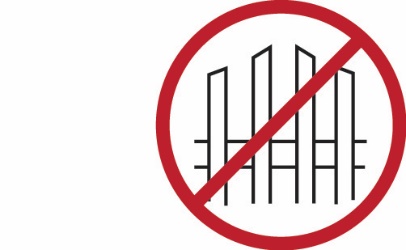
- Metal fences are not allowed to have spikes, arrows, finials, or fleur-de-lis at the top of their posts or pickets.
- Wood picket fences are not allowed to have gothic or colonial picket design.
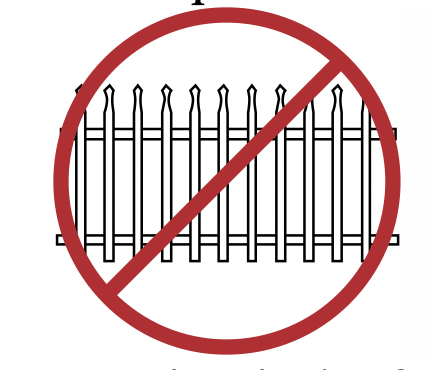

- Wood and wire fences similar to snow fences are not permitted.
- HELPFUL SUGGESTIONS
- Planting at each post may be desired.
- Heavy gauge wire mesh (e.g. .063” (16 ga.) through .120” (11 ga); 1x2 through 2x4) may be attached to the inside of wood board and post fences. All wire must be maintained in good condition, must terminate at a rail, and can be no taller than the height of the top rail. The bottom rail must be low enough to serve as a suitable terminus.
- Grass protection and flower bed fences under eighteen (18") inches in height are permitted. Consideration should be given to safety where they are adjacent to common walkways.
- A drawing that illustrates building a simple picket fence is available from Technical Services on request. This fence is built from pressure treated lumber available from any local lumber dealer.
- For suggestions on what fence is best for your particular home style please consult with the Architectural Review Committee (ARC).
- HELPFUL SUGGESTIONS
Members are to notify GHI of the intent to remove fence(s). Removing fences on a shared yard line also requires notification of immediate affected neighbor(s). GHI will remove a member's fence, at GHI expense, if the current member requests that this work be done and agrees not to seek permission to install a replacement fence for a period of three years. It will be GHI's responsibility to fill post holes and tamp, seed and straw. Members will be responsible for removing any shrubs or foliage growing through or around the fence.




